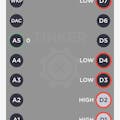In my raids, I often come to projects where old CD-ROM or DVD-ROM drives are exploited (yep: round about year 2000 is old). Especially the stepper motor, which moves the read head, is used in projects where, for example, the self-construction of a CNC station is concerned. This is why it is so good because the existing mechanics - the guide slide - is already there and we expose ourselves to no danger to life and limb.
Let's Take a Closer Look at This Stepper MotorI got four drives from a nearby electronics store that repairs desktop PCs:
- one from a laptop,
- one CD-ROM and
- two DVD-ROM drives.
Unfortunately, I did not know what to look for, so I ventured directly to laptop drive. Every cable and every mini-screw is removed until I finally thought: huh - now you've found the stepper, but now you can not solder the necessary 4 control cables.
Attention:
- Not all CD/DVD ROM drives have steppers.
- Sometimes you will find these also under the term "SLED engine".
What did I learn from this:
- In addition to the current-carrying typical cables, broadband cables are also there to conduct signals and close circuits. Since these are also soldered to components or the PCB, do not just remove it.
- Before you start get an overview of what you are actually looking for - because I had in advance no overview of what comes to me when disassembling the drives.
After that, I dismantled the other drives: first loosened the visible outer screws, worked them forwards over the front, and then carefully lifted the plastic inside out of the metallic body.
This brings us to our coveted target:
The stepper motor is the lower part with the shaft and the orange cable on it.
Wiring Arduino and Breakout BoardThe wiring is not further explained here with Arduino and TB6612. Please have a look at this help. Here you will find information, also to other engine controls.
Pairing the 4 Stepper CablesThe pairing of the 4 cables can be determined for MotorA + CoinA - respectively MotorB + CoinB with several methods:
- Coincidence - try it
- Use your multimeter and set "Ohm"
- Uses a LED - this lights when moving on the slide (demonstrated in the video)
Solder 4 cables either to the existing contacts of the motor or to the (here: orange) ribbon cable.
The quality of the carriage and the shaft is sometimes different: manufacturers save where they can and even manufacture the slide on one side of plastic. If the wave can be moved well by hand (= power off!), then you have a greasy film on your fingers.
Test itWhat Else is There to Explore?A small DC motor and a stopper component whose ends can be pressed in and thereby a trigger is set.
In addition the CD DVD Spindle engine, which brought the medium itself to the turning: a coil-wound motor, which is still sold today.
* Datasheet for a typical motor
* DigiKey table for stepper motors with 499 results!
Now I have a few of these engines over - may someone take over? PM me!
I wish all the others a lot of fun in assembling their own CNC machine.
How Does It Work with PHPoC? (Update 23.01.2019)If you've been working on PHPoC for a while, you can also do this setup with a PHPoC Blue / Black. An introduction to PHPoC can be found here.
Take the stepper motor expansion board PES-2405 piggyback on the blue board and following this guide for connecting the 4 cables or as explained directly in PHPoC tutorials. Check the pictures out.
Note that the example code can only be executed "local": this means that flashing the code via the PHPoC debugger (= IDE) causes an alert over the IP address of the board in the browser to an exit "0". You start the code using the play icon inside the IDE. That's all. ;-)
In general, make sure you have the latest release versions of PHPoC Debugger (v1.5.0), Expansion Board Firmware (v1.1) in case of PES-2405, and PHPoC Library (v2.2.1). Extract the ZIP archive and flash it to the board using PHPoC Debugger.
But Why Does the Sled Run Smoothly Over the Wave?This question is answered by the PHPoC support using the example of mapping the Arduino example code into the PHPoC Blue command world as follows:
"In Arduino, speed unit is rotations_per_minute. In PES-2405, speed unit is micro_step_per_second. Now let's convert speed from rotations per minute to step per second:
- We need to find the "steps_per_revolution" parameter on specification of motor.
Note that some motor specification provide "Step_Angle", which means "angle_per_step". In this case, we can calculate:
steps_per_revolution = 360 / angle_per_step
- Now we can convert speed from rotations per minute to step per second by using the following formula:
step_per_second = rotations_per_minute * steps_per_revolution / 60
- Since PES-2405 use the micro-stepping method to control motor, this method have two advantages: Make motor move more smoothly and control motor more precisely. Why? Because one step on full-step control can be divided to a number of micro-steps. This increases resolution of step motor. A number of divided micro-steps can be specified via
spc_request_dev($sid, "set mode $mode");
command. You can refer more here https://www.phpoc.com/support/manual...php?id=use_set
- Now we need to calculate:
micro_step_per_second = step_per_second * $mode
In your code, you use $mode = 4.
=> now can set speed via command:
spc_request_dev($sid, "set speed $micro_step_per_second");
Since you already set speed in "set speed command", you do not need to set speed when you use "move" command. You just need:
spc_request_dev($sid, "move $steps");
PES-2405 allows to set acceleration and deceleration via "set accel (accel) [decel]" command (see manual).
This is one of the factors make motor move more smoothly."
Thx support! You can follow the forum-thread to this topic here.
Test


_ztBMuBhMHo.jpg?auto=compress%2Cformat&w=48&h=48&fit=fill&bg=ffffff)






Comments
Please log in or sign up to comment.